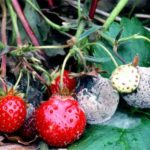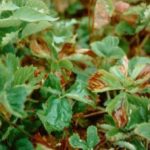Eating sweet strawberries will only come out under proper growing conditions and good care. In the opposite case, the plant may die due to the invasion of pests. In just a few days, bushes can be badly damaged or completely destroyed. Holes can appear on them as a result of the appearance of weevils, spider mites and other pests that love to eat around flowering bushes. How to deal with them and what to do further in the article.
Table of contents
- The main pests of strawberries and the fight against them with drugs and folk methods
- Weevil during flowering
- How to destroy ants in a berry?
- Whitefly and how to save the beds from her
- Strawberry leaf beetle: how to process a berry in spring?
- Nematode and ways to protect against it
- Medvedka and treatment of small pest beds
- Strawberry mite and an effective means of dealing with it
- Aphids on leaves and flowering strawberry bushes
- How to get rid of spider mites with ammonia?
- Slugs
- Tobacco tobacco: how to deal with it?
The main pests of strawberries and the fight against them with drugs and folk methods
There is a false opinion that strawberries belong to unpretentious plants that have good immunity to various diseases and pests. This is not so, as can be seen from the reviews of gardeners, who are increasingly complaining about the different ailments and a decrease in yield. Most of the problem is solved with proper preparation of the plant for planting and preventive measures. However, sometimes even the measures taken do not save strawberries from diseases:
- gray rot;
- late blight;
- spotting;
- verticillosis;
- powdery mildew.
If yellow spots appeared on healthy greens, or it began to fade and dry, it is necessary to immediately conduct an inspection to identify the cause. To eliminate harmful bacteria or microorganisms, special treatments are carried out.The new generation of medicinal products does not affect the quality and environmental friendliness of the fruit, so you should not be afraid for health. Along with biological and chemical products, no less effective folk methods of combating diseases and pests are used.
- Phytophorosis
- Gray rot
- Spotting
- Mealy dew
- Verticillosis
Weevil during flowering
The insect is a beetle with an elongated nose, like a proboscis. The gray-black body is only 3 mm long, but this pest can cause a lot of trouble. Weevil gives preference to berry crops, but ripe fruits are not interesting for him. In the buds of the berry crops, the females lay eggs, from which the larvae subsequently emerge. They eat away the flower from the inside, which ends with the death of the bud.
You can protect the next harvest by spraying the plant twice per season: in spring (one week before flowering) and in summer (in July). As the working composition are used: Fitoverm, Akarin, Iskra-bio.
Sometimes they carry out the third treatment, if insects were found on the beds.This can be done with drugs: Antonem - F, Namabact.
Among the effective folk methods of fighting the beetle:
- mechanical assembly from the bushes;
- planting nearby fields of fragrant herbs (wormwood, tansy, bitter peppers);
- treatment with mustard solution (per 100 g. blemish with 3 l of water);
- adhesive mixture based on soap (40 g.) and 3 kg of ash.

How to destroy ants in a berry?
Red ants love thick places and wet beds, therefore, they are often settled right in the strawberries, damaging the crop. Greens remain at the same time unharmed. To cope with insects will help tillage in the root zone. Means for this purpose are used very different:
- on the basis of liquid ammonia (50 ml of alcohol for 10 liters of water, consumption is 500 ml per bush;
- tinctures of wormwood and tansy.
You can also make powder from a mixture of copper sulfate and quicklime. An alternative is the layout under the bushes of fragrant herbs (mint, wormwood, etc.).
It is effective and safe to place yeast and sugar traps in the beds to collect insects and carry them out of the garden.It is also appropriate to dig up ant nests to extract eggs, followed by transfer beyond the boundaries of the site.
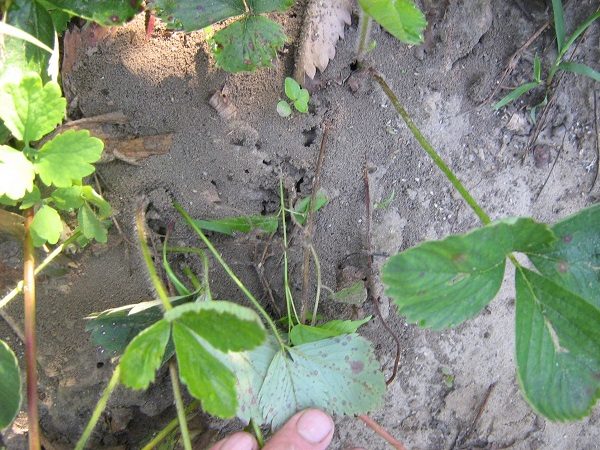
Whitefly and how to save the beds from her
The butterfly lays eggs under the leaves, highlighting a sticky substance that creates a favorable environment for the development of fungal diseases. The larvae actively suck the juice from the plant, which leads to the withering of the culture. It is difficult to cope with the pest because of omnivorous and high fecundity.
If an insect or signs of its presence are detected, it is necessary to carry out the treatment with Fitoverm. In addition to bio, gardeners also use the following methods of control:
-
- for the night they leave lighted lamps in the beds (butterflies, when they arrive in the light, they are burned);
- watering plants with plain water to wash them off the leaves (then you need to gnaw the ground);
- setting along the rows with strawberries sticky tape for flies.
To reduce the risk of nematode invasion is possible by enriching the soil with compost. Presence of microorganisms in n
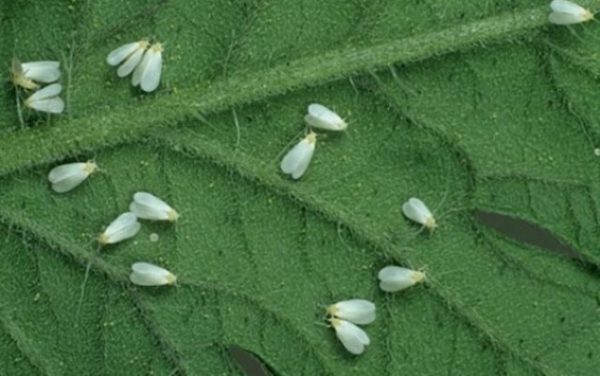
Strawberry leaf beetle: how to process a berry in spring?
A three-millimeter bug poses a danger to strawberry crops. Insects are en masse populated by plants, intensively eating leaves, buds, shoots. With that, the age of strawberries does not play any role, everything is used.
The first signs are:
- dried damaged leaves, buds;
- deformed underdeveloped fruit.
If parasites are detected, the area should be treated with insecticides. Among the popular drugs: Zolon, Aktar, Aktellik.
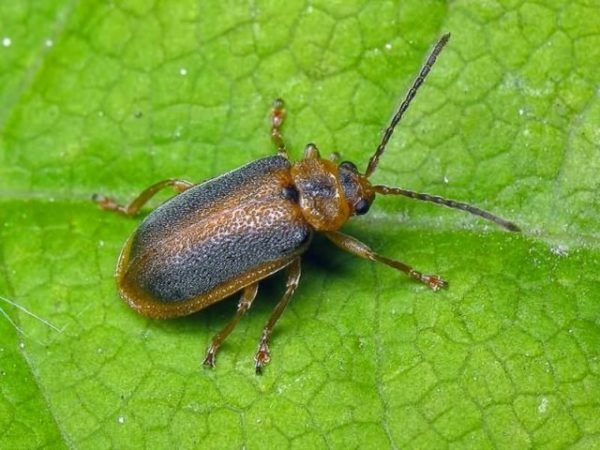
Nematode and ways to protect against it
Small-sized white worms can destroy the entire crop if the plants are not treated in a timely manner. Infection of the plantation occurs instantly, so it is not worth delaying spraying. Signs of the presence of nematodes are:
- yellowed foliage;
- the formation of white grains on the roots;
- shriveling greens;
- deformation of berries;
- drying the plant.
The marigold flowers are considered to be a real salvation from pests. They should be planted near the beds. Worms, eating flower roots, die because of a dose of poison contained in marigolds. Scares nematode and calendula, insects can not get close to the aromatic plant.
With a strong infection, it is rational to treat the beds with Skor and Fundazol solution. Preparations based on chemical compounds, but without potent formulations, the plantation cannot be saved.
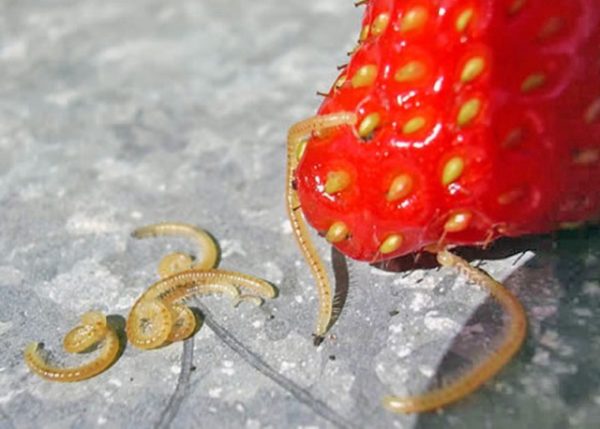
Medvedka and treatment of small pest beds
Insect is a danger not only for berry crops, but also for vegetables. Medvedka in the garden can be recognized by the burrows between the rows and under the bushes. She also does not mind eating strawberries, which is why many berries become unsuitable for eating when attacked by a pest. The parasite attracts soil, fertilized with humus. She can move directly into the hole with lure, so you should get accustomed to the seizure of each portion, intended for the beds. Medvedka, paving the way underground, often damages the root system.
Among the existing modern drugs to find a panacea does not work, because the insect adapts to any means. In order not to pollute the soil with chemicals, you need to try simple ways.
- Arrangement of special traps. To do this, dig a moat 40 cm wide, 40-50 cm deep and fill them with manure. In late autumn, when setting the night temperature below zero, the traps are excavated, and the filler is scattered around the garden. Parasites freeze and die.
- Regular soil loosening will benefit the plants and reduce the population of pests that die under the action of the tool.
- In different parts of the garden, you can equip traps from the pits filled with manure. It is sufficient to regularly conduct heap inspections to extract the parasite's lair.
- Watering the area with soapy water makes the crawling out of the coveted minks. Collecting them, you can also affect the decline in the population.
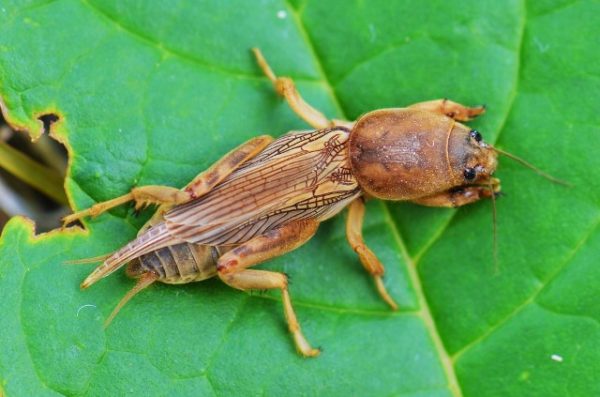
Strawberry mite and an effective means of dealing with it
Juice berries for insects are a real delicacy. And parasites are attracted by the warm humid climate. In such an environment, pests actively multiply, settling in whole hordes of strawberry plantations. It is very difficult to detect a strawberry tick due to its microscopic size, but it is possible to recognize the presence on the beds by the following signs:
- the appearance of damage to the sheets;
- slow development of shoots, buds;
- wilting greens.
Ticks are also dangerous because are carriers of fungal infectionstherefore, for the treatment of potent drugs are used, for example, karbofos. Spraying is carried out in two stages: at the beginning of the season (spring) and after picking the fruit.
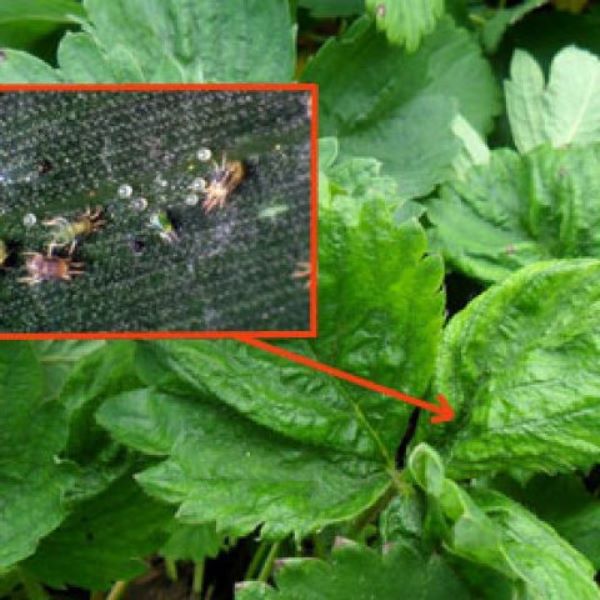
Aphids on leaves and flowering strawberry bushes
Microscopic insects suck the juice from the plant, as a result of which it fades and dies. When detecting a massive settlement of pests on the stems and under the sheets, it is necessary to carry out processing. For this purpose, special preparations (Kalash, Aktara, Fitoverm, etc.) or folk methods are used.
In order to prevent recommended to plant in the midst of strawberry bushes umbrella plants, herbs, as well as onions, garlic.
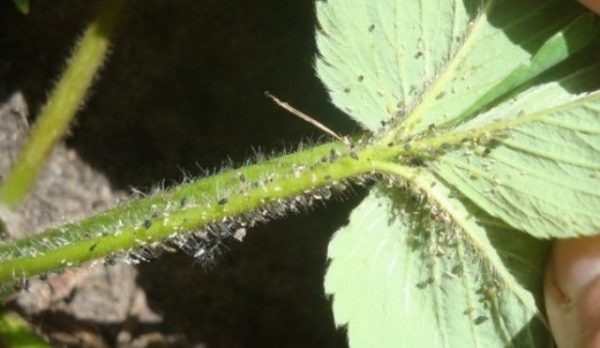
How to get rid of spider mites with ammonia?
Microscopic insects rapidly multiply in the warm springtime, so skipping the signs of the presence of a pest can be expensive. You can lose not only the harvest, but also the plantation.
In order to prevent, it is worthwhile to carry out regular weeding from the weeds and the inspection of the beds in order to identify the signs:
- dry edges of greenery;
- damaged leaves.
To detect the pest itself is unlikely to happen because of its small size. But a sure sign is local damage, covering several neighboring leaves on the bush at once.
Mite treatment involves the use of:
- drug Vermitek (10 liters of water 3 g. funds);
- solution based on ammonia (per 10 liters of water 2-3 tablespoons).
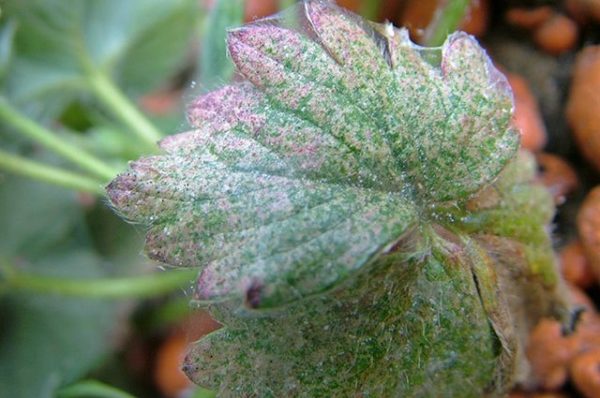
Slugs
Unpleasant sticky parasites willingly populate the beds, where there is high humidity, as the water for them is considered an integral part of life. The pest eats mostly berries, so if you invade without a quick response, you can say goodbye to the harvest.
For the purposes of prevention, it is worthwhile to irrigate according to the degree of soil moisture., to clear the beds from weeds, to mulch the soil. When a family of slugs is detected, it is necessary to treat the area with the use of drugs: Slimax, Metaldehyde.
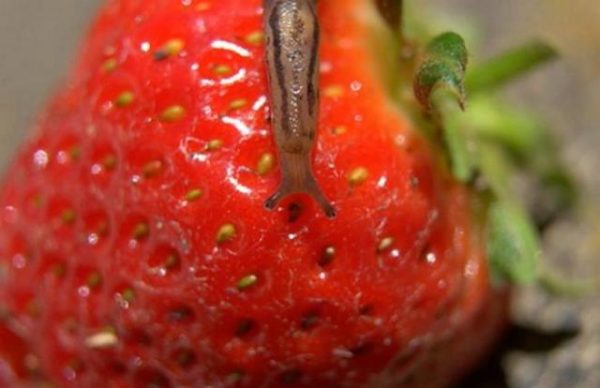
Tobacco tobacco: how to deal with it?
Harmful insects colonize the beds with berries, not only in the open field, but also in greenhouses. Owners of a wonderful appetite, they deal with plants in a matter of days, so you need to start processing without delay.
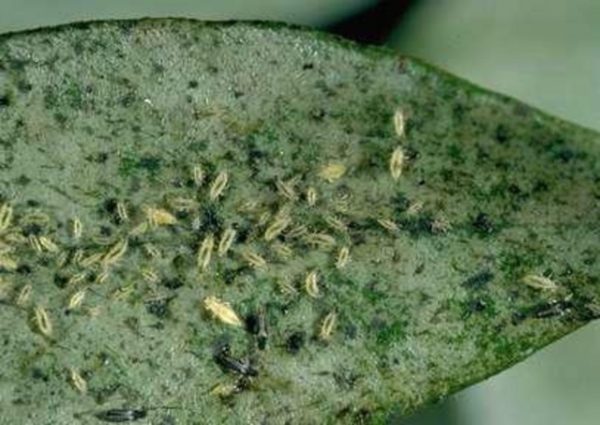
If it is difficult to diagnose a problem with a plant, It is worth resorting to the advice of a specialist. This will help to quickly select the desired drug and preserve the harvest of delicious berries, and at the same time save the plantation from death. After all, if you want to get rid of aphids, ants and other small parasites of berries, it is important to water the bushes in time to protect the crop.


